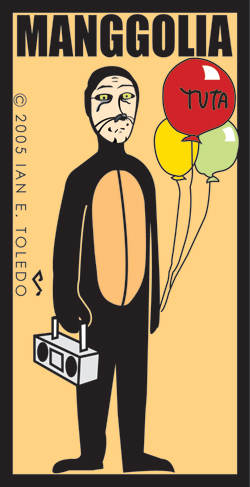Filed Under > TC People
A Graphic Life
Future generations of students may owe a sudden interest in art education to a surprising hero: Mighty Mouse.
"Art has always been natural to me," says Art and Art Education master's student Ian Toledo. "When I saw Mighty Mouse as a kid, I wanted to draw him. I liked his iconic colors, and I've been drawing ever since."
Toledo's long-standing passion for art led him to do graphic design for companies like the crystal manufacturer, Swarovski Group, as well as set design and production assistance for several independent movies. He wants to instill that same passion in others, so he's come to TC to become a teacher. He wants to get students excited through sequential art, better known as comic books and graphic novels.
"Sequential art has been around for centuries, starting with paintings on Egyptian walls, the Mayan Codex and the Bayeux Tapestries," Toledo says. "It documents tradition, history, culture and identity, and it is a great tool for students." He realizes that using comic books as tools for classroom instruction is fairly new and somewhat controversial. One criticism is that if students draw comics, they will end up only learning to copy the style of existing artists. But Toledo notes that art students have long copied the great masters. "And you can't really become another artist," he says. "Your own identity will come out sooner or later." At the Bronx Lab School where Toledo student-teaches, teenagers work feverishly to bring that identity out, he says. "Students eat it up, boys and girls," he says. "Comics have traditionally been thought of as a boy's medium, but Japanese manga [highly stylized comics with more adult story lines] has brought more girls into the fold. Western comics are like action, action, action, but manga has a lot more genres, sports, romance, etc. The students learn concepts and techniques from each of them." Toledo's students are able to create art with stories that are individual to each of them. And the growing popularity in the alternative, cult crowd of turning manga into motion pictures, called anime, doesn't hurt either.
Toledo's emphasis on searching for identity through art may stem from his growing up as a Filipino American. "I've had my own struggles with cultural identity, feeling I don't belong here or there," he says. These struggles led him to create a graphic novel based on his own life. "Issues of identity are all throughout comics, and adolescents are constantly dealing with them. Sometimes I feel like I can relate to my students because I'm in the same boat."
Recreating his life has been cathartic for Toledo. "I was part of a church that was very bad, they were manipulative, even brain-washing. I didn't know it at first, but I escaped from that, and it was a very tough time. Creating my graphic novel has let me express my feelings about it." Working with EdLab at TC's Gottesman Libraries, Toledo asked local students to do the same thing, express themselves artistically outside of the classroom. Earlier this month, at an event called Edit Jam, students were offered various tools, turntables, paint, video cameras, and asked to do art answer the question, "How do you teach democracy?" The event was an extension of the new TC curriculum designed around Spike Lee's film about Hurricane Katrina, When the Levees Broke: A Requiem in Four Acts.
Recently, Toledo took his search for self-discovery back to the Philippines, where he learned more about the language and culture, particularly native Filipino mythology. One creature, called Bakunawa, which native tribes believe cause eclipses, caught his imagination, a black dragon with bat wings, eyes and whiskers like a cat and a fin like a shark. Some regions see the beast as a symbol of despair, but others see it as a symbol of change. Toledo uses these symbols in telling his life story to show that the latter can come from the former and that art can help point the way, even if it begins with drawing Mighty Mouse.
Published Friday, Apr. 27, 2007
